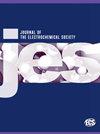The Dominant Effect of Electrolyte Concentration on Rechargeability of γ-MnO2 Cathodes in Alkaline Batteries
IF 3.1
4区 工程技术
Q2 ELECTROCHEMISTRY
引用次数: 0
Abstract
Achieving high cycle life rechargeable γ-MnO2 cathodes in alkaline batteries face many challenges. Chief among these is the inability of the γ-MnO2 polymorph to retain its structural integrity when cycled to high utilization of its theoretical capacity ∼300 mAh g−1. In this paper, we investigate the root cause of failure of MnO2 cathodes under deep cycling in the one-electron discharge range and establish a strong link between capacity fade and the amount of birnessite formed. We uncover the underlying cause of failure by cycling industrial scale γ-MnO2 cathodes at various levels of theoretical capacity utilization (100%, 50%, and 30%) and in different KOH concentrations (37, 25, and 10 wt%). To determine materials evolution the cycled cathodes were dissected, characterized and analyzed using SEM, XRD, FIB/SEM, EIS, and XPS. Based on our findings, we propose that one major cause of failure of MnO2 cathodes stems from the solubility of Mn+3 formed during discharge which effectively results in destruction of the γ-MnO2 phase and amorphization of the cathode. The results show that the bulk of the γ-MnO2 phase is preserved only in ∼10 wt% KOH, which indicates the attractive range of KOH concentration for cycling of rechargeable γ-MnO2 cathodes.电解质浓度对碱性电池中 γ-MnO2 阴极充电能力的主要影响
在碱性电池中实现高循环寿命的可充电γ-二氧化锰阴极面临许多挑战。其中最主要的挑战是当γ-MnO2 多晶体的理论容量 ∼300 mAh g-1 循环到高利用率时,它无法保持结构的完整性。在本文中,我们研究了 MnO2 阴极在一电子放电范围内深度循环失效的根本原因,并确定了容量衰减与形成的桦辉石数量之间的密切联系。我们通过在不同理论容量利用率水平(100%、50% 和 30%)和不同 KOH 浓度(37、25 和 10 wt%)下循环使用工业规模的 γ-MnO2 阴极,揭示了失效的根本原因。为了确定材料的演变情况,我们对循环阴极进行了解剖,并使用 SEM、XRD、FIB/SEM、EIS 和 XPS 对其进行了表征和分析。根据我们的研究结果,我们提出 MnO2 阴极失效的一个主要原因是放电过程中形成的 Mn+3 的溶解性,这有效地导致了 γ-MnO2 相的破坏和阴极的非晶化。结果表明,只有在 ∼10 wt% 的 KOH 中才能保留大部分 γ-MnO2 相,这表明 KOH 浓度对可充电 γ-MnO2 阴极的循环具有吸引力。
本文章由计算机程序翻译,如有差异,请以英文原文为准。
求助全文
约1分钟内获得全文
求助全文
来源期刊
CiteScore
7.20
自引率
12.80%
发文量
1369
审稿时长
1.5 months
期刊介绍:
The Journal of The Electrochemical Society (JES) is the leader in the field of solid-state and electrochemical science and technology. This peer-reviewed journal publishes an average of 450 pages of 70 articles each month. Articles are posted online, with a monthly paper edition following electronic publication. The ECS membership benefits package includes access to the electronic edition of this journal.

 求助内容:
求助内容: 应助结果提醒方式:
应助结果提醒方式:


